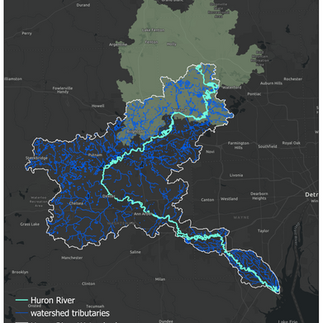Home to Aquatic Life and Communities of People that Rely on a Clean Water Source
Like the Shiawassee River, the Huron River begins in Springfield Township of Oakland County and its drainage area, or watershed, includes seven Michigan counties. The Huron River’s headwaters are fed by Big Lake and nearby swamps. The river flows south, passing through and providing drinking water to Milford, Ann Arbor, and other major communities until it drains into Lake Erie in Monroe County. Like the Clinton River Watershed, the Huron River Watershed contributes to the greater Lake Erie Basin.
The Huron River is recognized on a local, state, and national level as a valuable waterway. The majority of the 126 mile river is part of the National Water Trails System, which provides public recreation for paddling, fishing, and hiking through a number of access sites. The Huron River is 1 of the 16 designated rivers under Michigan’s Natural Rivers program. This means any development or land use change within 400 feet of the mainstream and most of its tributaries is regulated by the state. Local watershed councils and conservancies address pollution and protect the entire river system beyond federal and state efforts.
Like many urban rivers, the Huron has a history of detrimental pollution from agricultural runoff and dumping of chemicals and sewage throughout the 20th century. Citizens along the river took action by lobbying for change and demanding a better wastewater treatment process. Local government units were able to form and fund committees that maintained surveillance of the river quality. With the help of statewide legislation setting limits on toxic discharge, the Huron River’s water quality has improved over recent decades, but the river continues to be impacted by human activities like dam construction.
The upper portion of the Huron River Watershed contains a significant amount of lakes, ponds, streams, tributaries, and woods that provide diverse habitat for plants and animals as well as high quality recreation and game areas for people. The river is a reputable warm water fishery and one of the finest smallmouth bass fisheries in the country. Species like small and large-mouth bass, walleye, steelhead trout, muskie, northern pike, bluegills, catfish, carp, minnows, darters, suckers, and sunfish all rely on a clean water source to thrive in the Huron. Preserving the upper portion of the watershed ensures the ecological health of the rest of the river and its inhabitants downstream.
On the northwest side of Big Lake, a part of the headwaters that feeds the Huron River, Blue Heron protects 60 acres of private woodland through a conservation easement acquired in 2003. The property, known as Clarkston Woods Park, has steeply rolling hills covered with second and third growth hardwoods. It includes vernal pools and a buttonbush swamp. Less than two miles southwest of this property is another private easement property with similar landscape characteristics called Hidden Ridge. It is 93 acres in size and its easement—the legal agreement of perpetual conservation despite changes in ownership—was acquired in 2000. Both of these properties lie on the border of the Huron River Watershed and the Shiawassee River Watershed. Preserving and stewarding natural resources is especially important in this area, where we can essentially support two major river systems simultaneously.
Protecting woodland ecosystems like Clarkston Woods Park and Hidden Ridge in the headwaters region of a watershed ensures cleaner water and flood prevention at the source. Woods and forests are some of the best types of land for purifying and slowing down stormwater. The ground has a naturally high permeability, so it allows water to percolate through soil and root systems that filter out pollutants. In contrast, cemented surfaces and stormwater drains have little to no permeability, thereby flooding communities and local waterways with polluted runoff. A woodland’s absorption of rainwater also recharges the groundwater aquifers, a common drinking water source. Clean groundwater is also important for the river and its tributaries, since the water cycle flows between these reservoirs seasonally. From the higher parts of woods, the tree canopies intercept falling rainwater, reducing the pounding impact of heavy rains on the ground and preventing erosion.
Blue Heron takes steps every day to bring more woods of the Huron River Watershed under its protective wing. Together, Blue Heron with the Huron River Watershed Council assessed an additional 16 properties with conservation potential in the upper portion of the watershed. Conservation potential exists in this beautiful natural area, both for privately owned easements and for land with public recreation potential that can be purchased outright. Scouting efforts, easement agreements, land purchases, stewardship, and creating recreational opportunities requires a dedicated team, hours of hard work and continuous support from those who care about safeguarding the Huron River and its interconnected watershed.
Supporters like you are the heart of Blue Heron Headwaters Conservancy’s mission to protect the Huron River Watershed. Your contributions preserve vital ecosystems, ensure clean water for wildlife and communities, and safeguard critical habitats for future generations. As Giving Tuesday approaches on December 3rd, consider joining us in Give for Green. Every donation is matched up to $10,000, doubling your impact and fueling the work needed to protect these essential natural spaces. Together, we can make a lasting difference. https://donorbox.org/giveforgreen 💚 #giveforgreen #natureworthpreserving
Works Cited
“Features.” Huron River Watershed
Council, 25 July 2024,
“History.” Huron River Watershed
Council, June 2020, www.hrwc.org/about/history/.
Accessed 20 Nov. 2024.
Huron River. 26 July 2024,
www.americanrivers.org/river/huron-river/. Accessed 20
Nov. 2024.
“Natural Rivers.” www.michigan.gov,
“The Huron River · Exhibit · Give Earth a Chance: Environmental Activism in
Michigan.” umich.edu, 2017,
















Comentários